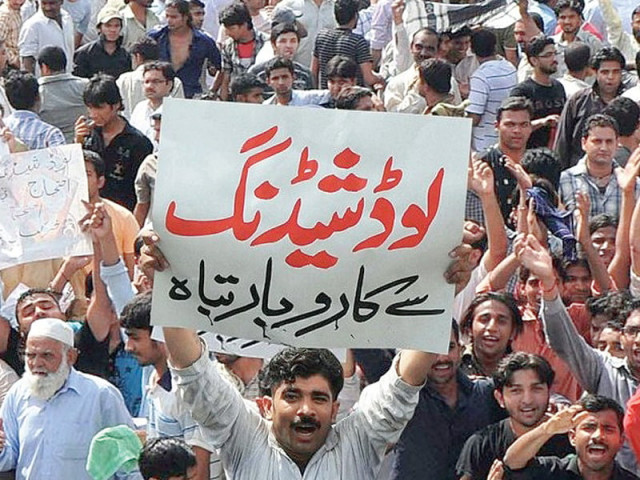2012, 2013 power woes: Political rivals follow same script to fend off public ire
While PTI & ANP blame centre and each other,PESCO tries to find a different tack with current and previous governments

Residents protest excessive power cuts in Kohat. After the ANP which faced the brunt of the power crisis in the 2013 general elections, it remains to be seen if PTI will survive the test of time. PHOTO: FILE
The Pakistan Tehreek-e-Insaf (PTI) in its current regime, and the Awami National Party (ANP) in its previous tenure, had a similar message in response to power outages and the growing anger of the public.
When the frequency of protests against power outages increased in the months of July and August, both the PTI and ANP reacted the same way – blaming the centre for power woes.
And while the parties have the same stance on the power issues in Khyber-Pakhtunkhwa, it does not stop them from pointing fingers at the others’ failure to resolve the electricity issues in their respective terms.
An illustrative parallel is a call to protests by Chief Minister (CM) Pervez Khattak and in July 2012 by ANP stalwart Ghulam Ahmad Bilour. Both men stated they would join the people on the streets if the federal government does not help alleviate K-P’s power problems.
Summer of 2013
As power woes kept pummeling K-P, CM Khattak started issuing statements asking the Ministry of Water and Power “to provide the province with its full quota of electricity”.
According to Khattak, the province was facing a literal meltdown for two reasons: “the federal government is not giving us our power quota” and “unannounced forced load-shedding through the Regional Control Centre Islamabad”. K-P’s requirement is 2,700 MW per day but both K-P and the tribal areas are only receiving 1,700 MW, maintained Khattak.
The WAPDA play
In a media briefing at the CM House, K-P finance minister Sirajul Haq argued the centre should relieve the Water and Power Development Authority (Wapda) of its Rs3 trillion debt and “then hand it over to us (KP) for efficient power production”.
At a news conference on July 30, 2012, flanked by senior party members, ANP provincial president Senator Afrasaib Khattak maintained, “Wapda has totally failed and is unable to run the system. Time has come to do away with Wapda and to delegate the subject of power to the provinces for better management”.
“That load-shedding is managed from Islamabad is illogical and this centralisation has created many issues.” Afrasaib went on to add, “Power companies in every province know better the needs of their respective areas.”
Calling for a conference
As the situation spiraled out of control in 2012, the ANP called an all-parties conference (APC) on August 9, 2012. The opposition boycotted and called it a “fruitless exercise”. The ANP then convened an Energy Conference attended by the Peshawar Electric Suppy Company (Pesco) officials and its coalition partner, the Pakistan Peoples Party.
Having seen the ANP trip over the attempted APC, the PTI leadership has learnt its lesson. The PTI claims it would take the issue of power directly to the centre, therefore avoiding direct criticism by the opposition, something the party would have to face in an all parties gathering.
Right back at you
After blaming the centre, it seems the most convenient fallback for both parties is circuitous blame.
The PTI leadership criticises the ANP for failing to produce a single megawatt of electricity during its five-year rule, which the ANP leadership counters by pointing out the PTI’s failure to bring about any change, including the solution for current power woes as it nears its 90-day target.
The PESCO verdict
The utility company has been giving different versions of the ‘power woes’ story to each government.
In meetings with the ANP during its last tenure, Pesco would maintain areas involved in electricity theft had to face more load-shedding than other areas. Back then, Pesco chief Tariq Sadozai made no mention of out-dated transmission systems, which needed Rs23 billion to be upgraded to better manage the load.
However, Sadozai has adopted a different tone during the current government. As a first, he has laid the blame of power outages at the feet of the out-dated transmission and distribution system.
Both governments also continue to criticise the Pesco head.
Like its predecessor which claimed it had enacted a plan for power generation that would come to fruition in seven years, the PTI has no option but to wait till 2017. That is when the country’s energy plan visualises an exit from the crisis.
One thing remains certain, the summer has almost come to an end, and soon the public anger will also melt away and change direction. After the ANP which faced the brunt of the power crisis in the 2013 general elections, it remains to be seen is if PTI will survive the test of time, summer after summer.
Published in The Express Tribune, August 9th, 2013.













COMMENTS
Comments are moderated and generally will be posted if they are on-topic and not abusive.
For more information, please see our Comments FAQ